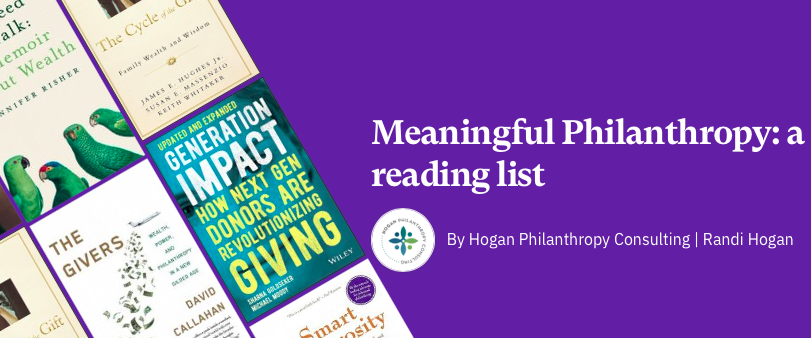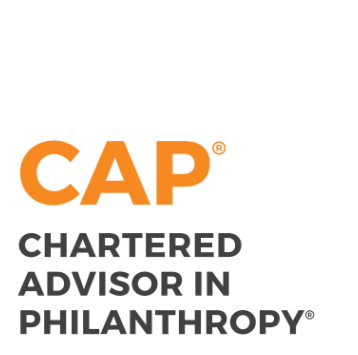What’s the best way to give to charity?
Randi Hogan was interviewed by Christina Gamache, founder of Audax Wealth Management, a boutique investment management and financial planning firm.
Christina Gamache: Hi Randi, thanks for joining me. Today we are talking about a topic that is near and dear to my heart. Charitable giving. I believe it’s something that should be an integral part of everyone’s financial plan. Because of the crazy pandemic year that we’ve had, I know a lot of non-profits are hurting financially. But, I’ve heard from a few clients that they do still want to support their favorite charities.
Randi Hogan: It’s good news that many have recovered from the initial economic shock of this pandemic and, like your clients, want to be charitably involved. I am seeing that a lot of people feel motivated to give more now than perhaps ever before. We know that this year has stressed and stretched nonprofit organizations and tested the resolve of staff and boards who have had to make difficult decisions to sustain operations. Those that have survived multiple crises want very much to connect with their supporters. Financial contributions, volunteer time and pro bono expertise, and social connections are particularly valuable for nonprofits now. We need generous people to fuel their dreams for vibrant communities. That’s why I’m excited to be in this conversation with you about how people can give effectively and meaningfully.
CG: So, what is the best way for an individual to give to non-profits this year?
RH: When it comes to figuring out the best approach for charitable giving, I often hear people ask the “how” questions first. How should I give? Stock or cash? Should I set up a donor-advised fund? How do I know when it makes sense to start a family foundation? These practical questions are important, but the answers are best determined after you have explored a more powerful question: Why?
Borrowing from Simon Sinek, author of “Start with Why,” inspired philanthropists start with their “why.” Why are you moved to dedicate a portion of your assets for charity? Once you understand your purpose, your giving will become more intentional. Take the time to identify your personal motivational values, the societal and cultural issues that you care deeply about, and what kind of world you seek to cultivate. Develop this further by writing a mission statement for your philanthropy. Taking this foundational step will help you reach a level of clarity that will guide your path to purposeful and informed giving. How you approach charitable giving is part personal discovery. As a philanthropy advisor who works with donors to discern their giving intentions, I have found that families who come together to reflect on these questions and articulate their values find meaning for themselves as they give to benefit others.
CG: Audax Wealth Management supports several nonprofits in our community. How does someone decide which charities to support? There are so many that need our help!
RH: Your personal philanthropic mission statement will be the best framework for this decision. Because, as you point out, there is a multitude of tax-exempt organizations and causes (1.6 million in the United States alone!), you will want to narrow your options down. Consider defining a geographical scope, size of organization, and the kind of approach to the impact you seek (for example, meeting immediate needs or addressing root causes). Do some research to uncover close matches with your philanthropic mission. Involve both your head and your heart at this stage. You might start online with data and evaluation sites like Guidestar, Charity Navigator, or CharityWatch, but don’t stop there. Go to the source: visit your selected charity websites, look for published plans and reports, speak with the staff, and attend an event or visit their site (if possible) to see its work in action. Look for their results and seek to understand what difference your participation will make in their efforts.
CG: From a financial planning standpoint, I know a lot of giving has actually decreased since 2018 when the standard deduction increased and people were no longer able to itemize. People shouldn’t give just to get a deduction, but it definitely helps.
RH: Yes, in a study last year, nearly half of advisors reported that many or most of their clients adjusted their charitable giving strategy in response to tax reform. In fact, many increased their giving due to the loss of other deductions. However, we agree that charitable giving – how you leave your mark on the world – is much more than finding a solution to reduce or eliminate your taxes. I encourage people to start by asking their financial advisor to help determine an amount that will benefit their tax situation and maintain their financial goals. From there, a charitable giving budget can form the platform for annual and lifetime giving decisions.
CG: Should people give in the beginning of the year, throughout the year, or at the end of the year?
RH: The end of the year is when many people give to nonprofits. In fact, 30% of annual giving is made in December, with a major surge in giving the last three days of the year. But of course, nonprofits need funding throughout the year. Discuss with your financial advisor how giving earlier in the year can support your financial goals. Consider, for example, transferring appreciated stock during a market high, sharing part of a quarterly bonus, or setting up a monthly giving schedule. Some donors appreciate that giving monthly helps them give more over the course of the year and helps nonprofit organizations improve their long-term planning. Giving in December is often in response to letters or emails from nonprofits, and many donors react to what’s at hand and send off gifts to what appeals to them. At some point, though, this kind of reactive giving will feel inefficient and less than satisfying. That’s why I encourage individuals and families to develop a giving plan.
CG: Reactive giving, or “checkbook giving” is difficult for a lot of families. Many times, families are not able to help out as much as they would like because they haven’t planned for it. How can a donor move beyond this? What is involved in a giving plan?
RH: An informed charitable giving plan is where all the elements we’ve discussed earlier come together. Beginning with your personal philanthropic mission statement, your selected list of groups that align with your mission, and a charitable giving budget, you will have a strong framework to be more strategic with what truly interests you and reflects your values.
Consider a tiered giving approach, in which you apportion a significant majority of your charitable budget to focus on one or two issue areas or causes, and then split the rest to other groups you want to support with smaller annual gifts or to honor obligations. You might also reserve a little to respond to emergency relief efforts or new requests from friends and others in your network who invite you to support their causes. Your tiered approach could break down like 80%, 15%, 5%; or 70%, 20%, 10%.
After the first year of working with your new giving plan, take time to reflect on your experience, make adjustments, and plan your involvement in the following year. Ideally, you will develop a long-term strategy and form lasting and meaningful partnerships.
CG: That’s a great idea, and a unique way of approaching a giving plan. I hear from clients who want to give, but they’re always waiting for the next natural disaster or emergency or haven’t thought about the big picture. Having a thoughtful budget makes a lot more sense. What about DAFs? Donor Advised Funds? Are they good vehicles to give?
RH: We’re at the time of year when decisions need to be that aren’t necessarily compatible with direct and immediate giving to individual charities. For example, when you want to take advantage of the timing of tax deductible giving but for one reason or another, you are not ready to give to a particular charity. A Donor Advised Fund, or DAF, acts as a temporary parking lot for your money. A DAF is a charitable giving vehicle administered by a public charity. It allows donors to make a charitable contribution, receive an immediate tax deduction and then recommend grants from the fund over time. A DAF is meant to be used later for other charities, which is why I called it a “temporary parking lot.” Sometimes you need to buy some time to make a decision about where and how you would like to allocate your giving, or the amount you have available to give is more than you want to apportion to any single group. This is how a DAF can be helpful. However, keeping in mind that the purpose of these funds is to fuel your philanthropic mission, I encourage DAF holders to distribute their funds as soon as possible.
CG: I like that analogy of a “temporary parking lot”. Donors get the tax deduction right away, but can take their time deciding which charity to donate to. Also, DAFs are great for passing on charitable intentions within a family. Parents can name their children, for example, as successor trustees of the DAF. Thank you, Randi, for all of your great tips. Philanthropy is more important than ever this year, and I believe it will “take a village” for us all to be able to recover. Any parting thoughts for us?
RH: Yes, I have two parting thoughts. First, seek good advice and invest in your own learning. If any of part of what was discussed here sounds overwhelming or complex for your family, you’re not alone. Consider bringing in a trusted advisor who can help you discover and define your philanthropic values, create a personalized framework for charitable giving, conduct research and evaluate options for charitable partners, and coordinate with your other professional advisors to develop a holistic legacy.
And finally, have fun! You will discover wonderful opportunities that make your heart come alive and connect you with inspiring people. Your journey as a philanthropist can be one of the most joyful, fulfilling parts of your life.
CG: Great thoughts! If you want to see more of what Randi is doing, check out her website at www.hoganphilanthropy.com.
charitable giving financial planning end of year philanthropy women families donor advised funds

When you subscribe, you’ll receive a periodic newsletter filled with powerful stories, ideas for action, and curated resources to help you align your giving with your life’s purpose. Sign up to explore new pathways to using your power for good.








